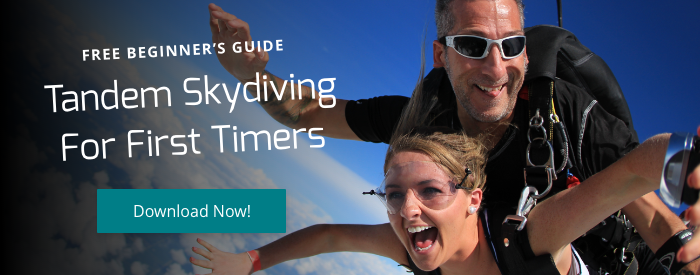First-time skydivers often do their due diligence before taking the jump by researching their freefall online. One topic of deep interest is skydiving safety, specifically, questions about your tandem skydiving partner’s qualifications, how long the fall will last, and — of course — how fast it’ll be.
Rest assured, you won’t be full speed ahead for the entire skydive! In this post, we’ll discuss the speed of your descent at different stages of your fall and how skydiving centers guarantee smooth sailing every time.
What’s The Fastest Speed When Skydiving?
After you take the leap of faith from the airplane, you and your certified tandem instructor are instantly airborne! During the start of your freefall, a drogue parachute will immediately be deployed. The drogue is there to help slow down your descent rate and keep you and your instructor in the right orientation: belly-to-earth.
The drogue and belly-to-the-earth positioning help limit your freefall speed to around 120 mph. This maximum speed phenomenon is something called terminal velocity, or the speed “cap” when a falling object is met with enough resistance to prevent further acceleration. In other words, once you reach 120 mph, you won’t keep accelerating. You’ll maintain that rate of descent during your freefall until your main parachute is deployed.
Is the Freefall Speed Consistent?
Depending on your jumping altitude, skydivers typically enjoy 30 to 90 seconds of freefall. This is when your only support is your drogue chute and you are enjoying the fastest speed of your entire freefall.
But once you hit 5,000 feet above the ground, your tandem instructor will deploy your main parachute. This parachute is the big rectangular canopy that will slow down your acceleration so you can safely land.* As soon as you reach 5,000 feet above the ground, your speed will gradually decrease as your canopy does its job!
*It’s important to note that every tandem skydiving system is also equipped with a reserve parachute. Should your main canopy have trouble deploying, this reserve is your trusted backup. Reserves must be inspected and repacked every 180 days by an FAA-certified parachute rigger to ensure they are safe as can be.
Have No Fear, Your AAD Is Here!
Even after knowing your speed won’t increase as you fall, you may still be nervous about your skydiving instructor deploying the parachute at the right time. Let us address this concern by first sharing just how much schooling tandem skydiving instructors need to become jumpmasters and be qualified to freefall with first-time skydivers. To even get their initial tandem instructor certification, they need to complete 500 jumps and three hours of freefall time. For perspective, you can expect close to one minute of freefall per skydive. Beyond that, many of our instructors at Chicagoland Skydiving Center (CSC) have been doing this for a decade or more, so you can have complete confidence in us. In fact, we have a 100% student safety record. Trust us — you are in good hands. Learn more about the qualifications of our impressive instructors here.
If, for some reason, your skydiving instructor is unable to deploy the parachute, you are unable to deploy it as well (we’ll teach you this in your pre-jump training), and both your main AND reserve parachutes are inaccessible — something that’s never happened at CSC — your parachute system is equipped with a safety device called an Automatic Activation Device (AAD). This handy device monitors your altitude and rate of descent. At a preset altitude, the AAD will automatically deploy your reserve parachute. This backup system is just another layer of protection, promising you a safe tandem jump every time.
Descent Speed & the “Stomach Drop” Feeling
We’ve all been on a rollercoaster and experienced that stomach lurch when we drop from the top. Many first-time skydivers assume that the stomach stress they experience on a big coaster is akin to that skydiving freefall feeling, however, it’s really not!
You see, the airplane isn’t just floating still in the air. It’s usually moving close to 100 mph when you get ready for the jump. On a roller coaster, you typically creep slowly to the top and almost come to a complete stop before the drop — promising the ultimate suspense and thrill. In an airplane, your body isn’t as shocked by the change of speed, given you fall at about the same speed the plane is moving (a 20 mph difference, roughly). The only stomach fluttering you’ll have is from those normal pre-jump nerves. During the fall, you’ll be in such wonderment at the wind and scenery, you’ll hardly be thinking about your tummy!
The Ultimate Guide for Preparing for Your First Skydive
Ready to finally cross skydiving off your bucket list? In our Tandem Skydiving Guide, we address a long list of FAQs for first-time jumpers, explain the mechanics of your parachute system, and more to help you gear up for the big plunge.
Download your complimentary copy today.


